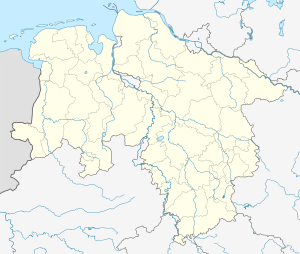Schöppenstedt
Schöppenstedt is a small town in the district of Wolfenbüttel, in Lower Saxony, Germany. It is the administrative seat of the Samtgemeinde ("collective municipality") of Elm-Asse.
Schöppenstedt | |
|---|---|
Timber framed house in Schöppenstedt | |
 Coat of arms | |
Location of Schöppenstedt within Wolfenbüttel district   | |
 Schöppenstedt  Schöppenstedt | |
| Coordinates: 52°07′59″N 10°46′42″E | |
| Country | Germany |
| State | Lower Saxony |
| District | Wolfenbüttel |
| Municipal assoc. | Elm-Asse |
| Government | |
| • Mayor | Karlheinz Mühe (SPD) |
| Area | |
| • Total | 39.65 km2 (15.31 sq mi) |
| Elevation | 100 m (300 ft) |
| Population (2018-12-31)[1] | |
| • Total | 5,474 |
| • Density | 140/km2 (360/sq mi) |
| Time zone | CET/CEST (UTC+1/+2) |
| Postal codes | 38170 |
| Dialling codes | 05332 |
| Vehicle registration | WF |
Geography
It is situated southwest of the Elm and Asse hill ranges, about 17 km (11 mi) east of Wolfenbüttel, and 21 km (13 mi) southeast of Brunswick.
Since 2007, Schöppenstedt station is the eastern terminus on the Wolfenbüttel–Helmstedt railway line.
History


The settlement of Sciphinstete in the Derlingau region of Saxony, located on the trade route from Brunswick to the Königspfalz at Schöningen, was first mentioned in a 1051 deed. A church at the site probably existed in the days of the missionary bishop Hildegrim of Châlons before 827 AD; Schöppenstedt later became the seat of a Halberstadt archdeacon. From 1267/1269, the surrounding estates were held by the Welf dukes of Brunswick-Wolfenbüttel. In 1542, the citizens turned Protestant.
A main landmark is the St. Stephen's Church with its famous leaning tower of the 12th century. The interior contains remarkable stone pillars with depictions of animal figures and human heads, including Wotan and his ravens, the Fenrir Wolf, the Midgard Serpent and the Ash Yggdrasil (black and white illustration). These ornate pillars have been constructed with the introduction of Christianity as a monument to the ancient gods of faith - the ornaments could date from the first documented mention of Schöppenstedt.
Schöppenstedt has a museum dedicated to the medieval trickster Till Eulenspiegel who was born in neighbouring Kneitlingen about 1300.
Notable people
- Ludwig Strümpell (1812–1899), philosopher and pedagogue
External links
| Wikimedia Commons has media related to Schöppenstedt. |